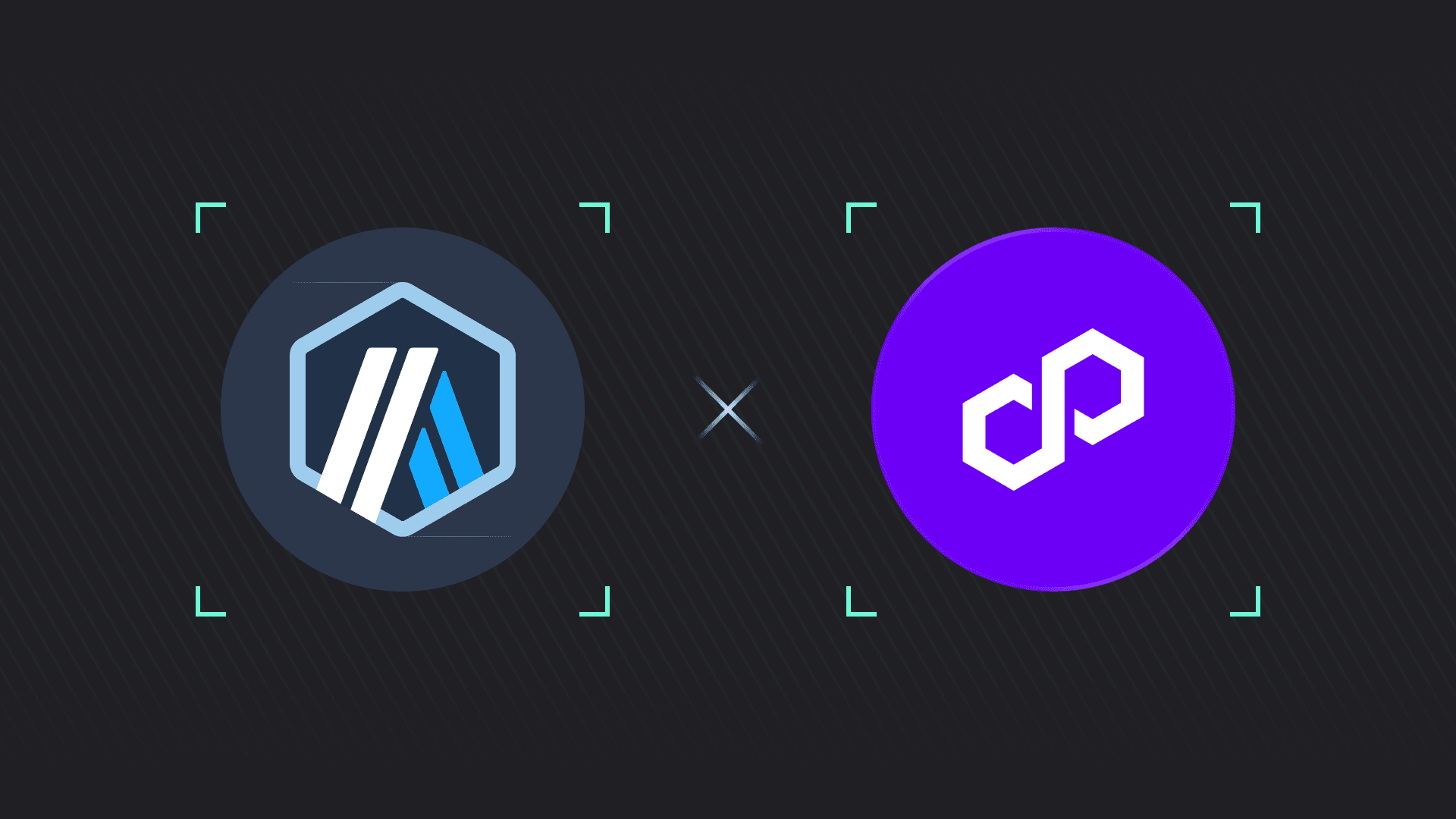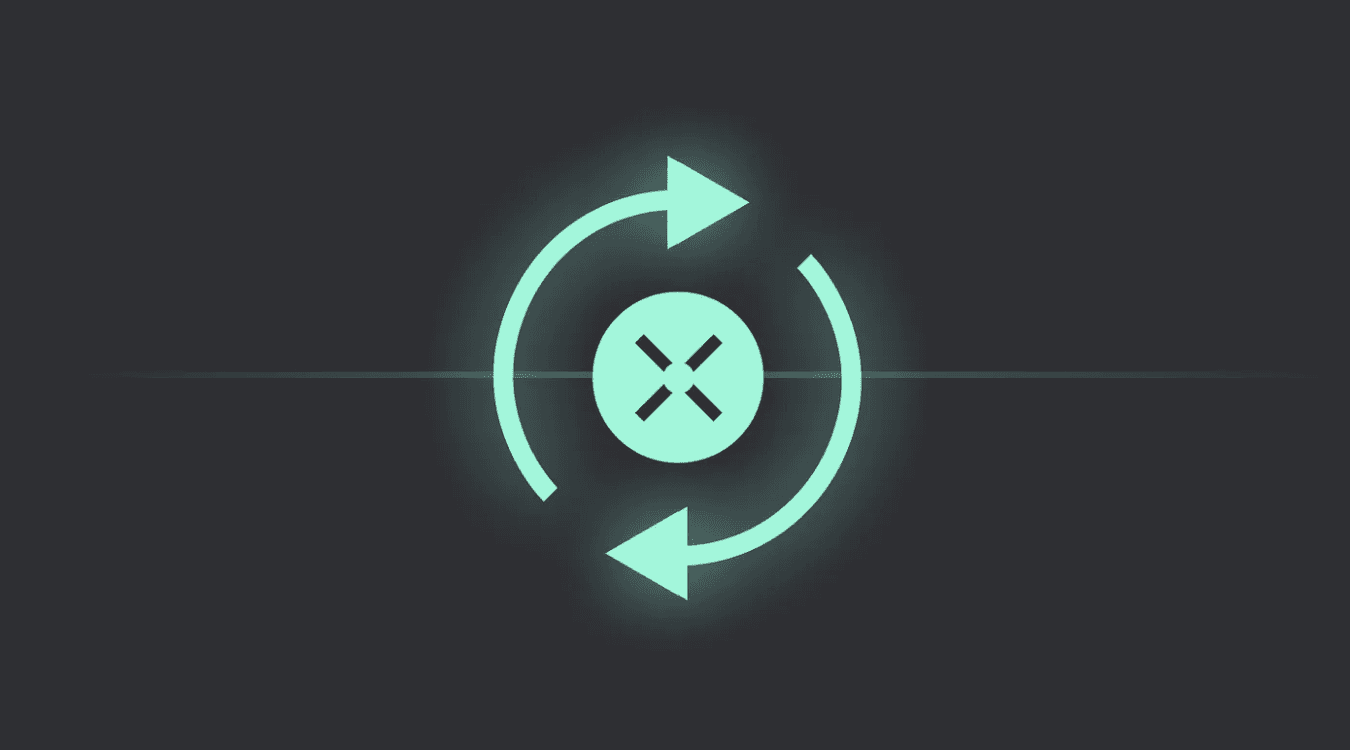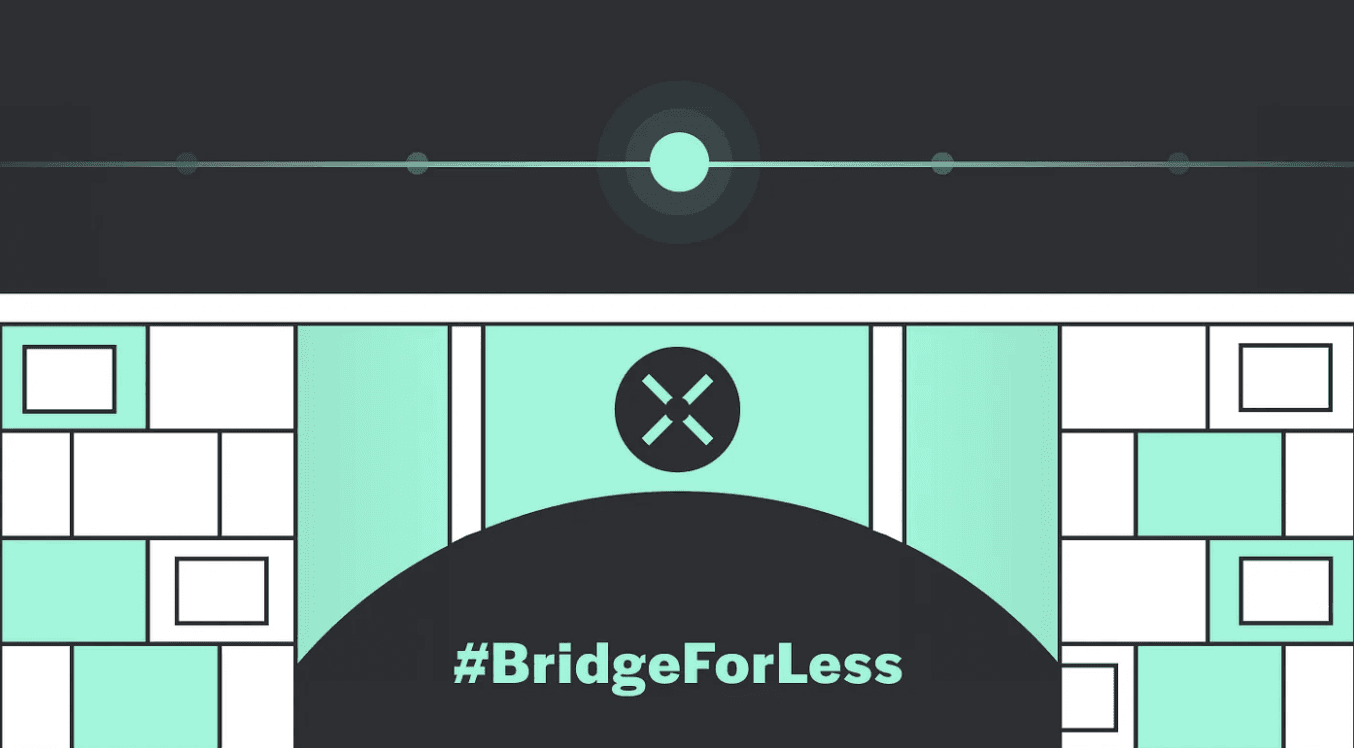Introduction
Ethereum’s transition to proof-of-stake solved its energy problem, but scalability remains a key challenge. Layer 2 solutions like Arbitrum and Polygon have emerged to help Ethereum scale efficiently, offering faster, cheaper, and more accessible alternatives to the mainnet.
For users and developers alike, choosing the right Layer 2 can have a direct impact on performance, cost, and opportunity. This guide breaks down the differences between Arbitrum and Polygon to help you choose the best fit for your onchain goals.
Arbitrum vs. Polygon: At a Glance
Arbitrum and Polygon are two of Ethereum’s leading Layer 2 networks, but they take fundamentally different approaches to scaling. While Arbitrum relies on optimistic rollups and focuses heavily on performance, Polygon supports a multichain architecture with both PoS and zk-rollups designed for modular scalability.
These differences shape how each network handles transaction validation, cost optimization, and developer flexibility. Whether you're building for DeFi, gaming, or consumer apps, understanding how Arbitrum and Polygon operate at a high level can help you choose the right stack for your needs.
Arbitrum | Polygon |
- Est. 2021, mainnet launch in 2021. - Scalability via Optimistic Rollups + interactive fraud-proof system. - Uses the Arbitrum Virtual Machine (AVM) for Ethereum compatibility. - DeFi-focused, with dApps like Uniswap and Synthetix using the network to scale. | - Est. 2017 as Matic Network, rebranded to Polygon in 2021. - Scalability via PoS sidechain and zkEVM. - PoS operates independently with periodic Ethereum checkpoints, while zkEVM uses zk proofs for security and efficiency. - Supports multichain architecture. |
At the time of writing, Arbitrum leads with a Total Value Locked (TVL) of slightly over $2.4 billion, while Polygon holds around $880 million. Arbitrum has processed over 1.5 billion transactions, reflecting its significant adoption, while Polygon, on the other hand, has processed 5.1 billion transactions, reflecting its long-time presence in the blockchain sector.
While both networks aim to scale Ethereum, they take very different paths to get there. Arbitrum prioritizes DeFi and high-performance applications through rollups and Layer 3s, while Polygon focuses on modularity, zk-based security, and mass-market adoption through both consumer and enterprise use.
Technical Comparison
While both Arbitrum and Polygon aim to reduce costs and increase throughput for Ethereum users, they do so with different technical foundations. Arbitrum uses optimistic rollups with a custom virtual machine, while Polygon takes a more modular approach with both a PoS sidechain and a zk-rollup.
These differences shape everything from how transactions are validated to how quickly funds can be withdrawn or confirmed on Ethereum. To understand what each network can offer, it’s worth looking under the hood at their architecture, security models, and scaling strategies.
Architecture & Network Performance
Arbitrum uses optimistic rollups and the Arbitrum Virtual Machine (AVM), which is compatible with Ethereum tooling and optimized for rollup execution. Its multi-round, fraud-proof system resolves disputes incrementally, minimizing data posted to Ethereum.
Polygon takes a broader dual approach with its PoS sidechain and zkEVM. The PoS chain runs independently and checkpoints to Ethereum, while the zkEVM uses zero-knowledge proofs for secure, trustless validation and fast finality.
Security Models
Arbitrum inherits Ethereum security and uses interactive fraud proofs to reduce challenge costs. The sequencer is currently centralized, with decentralization planned for 2025.
Polygon’s PoS chain relies on validators for consensus, offering speed but weaker trust assumptions. The zkEVM uses cryptographic proofs for trustless execution and is on a path toward decentralization.
User Experience
Arbitrum and Polygon both improve Ethereum’s scalability, but the day-to-day experience for users can differ widely. Transaction costs, speed, withdrawal times, and interface maturity all shape how users interact with dApps, trade assets, and move funds across networks.
Costs & Fees
Gas fees on Arbitrum in 2024 averaged ~0.1 Gwei. We have Arbitrum’s multi-round fraud-proof model to thank for reducing costs and maintaining gas efficiency over time.
Polygon zkEVM averaged ~1.9 Gwei in 2024, making it more expensive than optimistic rollups due to the computational cost of generating zero-knowledge proofs. However, it offers stronger security and faster withdrawals by eliminating the need for fraud challenges.
Polygon’s PoS chain averaged ~122 Gwei in 2024, making it the most expensive of the group. Since it operates as a standalone Proof-of-Stake chain rather than a rollup, its fees fluctuate based on network congestion and validator dynamics.
While Polygon offers flexibility through its PoS chain and zkEVM, its fees can be higher, zkEVM due to the cost of generating cryptographic proofs, and PoS due to validator dynamics and network congestion. Arbitrum, by contrast, consistently delivers lower fees, thanks to its Nitro compression and efficient fraud-proof system.
User Interface
Arbitrum boasts a developed DeFi ecosystem with a wider range of high-traffic dApps, many of which offer polished user interfaces due to the network’s broader adoption in the DeFi space.
Polygon offers a more consumer-facing ecosystem, with a wide range of high-traffic apps spanning NFTs, gaming, and enterprise loyalty programs.
Network Stability
Arbitrum ensures network stability even during high congestion periods. Its hard finality process generally also takes around ~13 minutes, relying on Ethereum’s finalization process.
Polygon’s PoS chain achieves near-instant finality, with Ethereum checkpoints occurring every ~30 minutes for added security. Withdrawals finalize within 2–3 hours. The zkEVM follows a three-stage process: transactions confirm on L2 in 2–3 seconds, then batch and sequence, before reaching L1 finality in 15 minutes to 3 hours, depending on network activity.
Developer Experience
Perhaps unsurprisingly, because Arbitrum and Polygon are both designed to scale Ethereum, they offer robust experiences for developers. These experiences differ slightly in terms of ecosystem adoption, tooling, and integrations.
Ecosystem Stats
Arbitrum | Polygon |
- TVL: ~$3.04 billion - Average transaction speed: ~21.8 TPS - Unique addresses: ~50 million | - TVL: ~$880 million - Average transaction speed: ~40.48 TPS - Unique addresses: ~500 million |
While Arbitrum’s larger TVL and deeper DeFi integrations make it the more dominant L2 for financial applications, Polygon dominates in overall usership, brand integrations, and multichain ecosystem support.
Developer Tools and Support
Arbitrum offers a broader suite of developer tools, including robust integrations and comprehensive documentation. Its Arbitrum SDK and strong ecosystem support make it an attractive choice for developers looking to migrate complex dApps onto Layer 2.
Polygon supports multiple scaling models (PoS, zkEVM, and CDK) and offers extensive documentation and tooling for both retail and enterprise developers. Its $1B grant initiative also continues to attract new builders.
Arbitrum vs. Polygon: Use Cases
Now that we’ve addressed the pros and cons of Arbitrum and Polygon for both users and developers, it’s time to dive into the actual use cases driving these L2 ecosystems. When selecting between the two, it's essential to consider the specific requirements of your needs or, for developers, the needs of your project.
For DeFi
When it comes to DeFi, Arbitrum leads in liquidity and transaction volume (TVL: $2.44 billion vs. $1.03 billion), making it a preferred choice for high-frequency traders and capital-efficient protocols. Polygon, while active in DeFi, focuses more on broad ecosystem growth across gaming, NFTs, and enterprise use cases. The choice between the two depends on whether you prioritize deep DeFi liquidity or multichain flexibility.
Arbitrum: GMX, a decentralized perpetual exchange, leverages Arbitrum's scalability to offer users efficient trading experiences.
Polygon: Aave, one of the largest lending protocols in DeFi, thrives on Polygon PoS due to fast execution times and minimal transaction costs, making it ideal for high-frequency lending and borrowing.
For NFTs
Both Arbitrum and Polygon are expanding their NFT ecosystems to offer scalable, cost-effective alternatives to Ethereum mainnet. While Arbitrum’s NFT activity is growing, Polygon has firmly established itself as the leading Layer 2 for NFTs, with integrations across major marketplaces, brands, and platforms.
Arbitrum: Shift aggregates listings across all the top Arbitrum NFT marketplaces to grow Arbitrum’s NFT presence.
Polygon: With OpenSea, DraftKings, and Magic Eden running on Polygon, it has become a go-to network for NFT trading. The PoS chain’s low fees and high throughput make it ideal for high-volume marketplaces and NFT trading. Meanwhile, zkEVM adoption is growing for premium NFT collections, as it offers stronger security guarantees and faster Ethereum finality.
For Gaming
In the gaming sector, where high transaction throughput and low latency are crucial, Arbitrum's infrastructure may offer a slight advantage over Polygon. But that isn't to say that each doesn't have their own merits.
Arbitrum: Treasure, developers of Knights of the Ether and other titles, utilizes Arbitrum to support its gaming ecosystem, benefiting from the network's scalability.
Polygon: Decentraland, The Sandbox, and Immutable all run on Polygon, leveraging its fast, low-cost PoS chain for in-game transactions and zkEVM for secure, high-value asset trading.
For Building
Back in the developer's corner, things aren't as straightforward, as builders must weigh factors such as tool compatibility, customization options, and community support when choosing between these L2s.
Arbitrum: Provides a flexible development framework, supporting a range of programming languages and offering tools for customized application development.
Polygon: Provides a flexible framework, supporting PoS for cost efficiency and zkEVM for security-consciousness. The multichain Polygon ecosystem, although sans full EVM equivalence, incentivizes customization, attracting Ethereum-native and crosschain developers.
Asset Interoperability
To extend your capital efficiency across Arbitrum or Polygon, you’ll first need to bridge your assets. As the L2 ecosystem expands, crosschain interoperability is becoming increasingly important. Of course, bridging isn’t always an easy process, because factors like speed, cost, and security all impact your user experience
Bridging Options
Users typically have two primary ways to move assets between Ethereum, Arbitrum, and Polygon:
The first is via native bridges:
The Arbitrum Bridge powers Arbitrum, allowing for direct asset transfers between Ethereum and its respective L2s, while the Polygon Portal facilitates asset movement on Polygon.
Arbitrum withdrawals can take up to seven days. Polygon withdrawals typically finalize in 2-3 hours.
Additionally, there are third-party bridges:
Protocols like Across offer faster withdrawals by using liquidity pools to facilitate instant swaps.
These services often offer cheaper fees and greater flexibility, allowing users to connect to multiple L2s and even alternative ecosystems.
Across, in particular, enables seamless crosschain interoperability, making it an ideal solution for users looking to bridge between Arbitrum and Polygon with greater efficiency.
While there are a variety of bridging options available on both Arbitrum and Polygon, it’s important to remember that bridging costs vary depending on network congestion, bridge design, and transaction size.
Security Best Practices
With bridges being one of the most targeted attack vectors in crypto, users should always take precautions when moving assets. This is true of interacting with any L2, including Arbitrum and Polygon. When considering bridging, be sure to:
Prioritize well-audited bridges with strong security track records (e.g., Across, with its robust security and a history of zero security incidents).
Verify contract interactions before approving any transactions to prevent malicious approvals.
Monitor transaction confirmations to ensure assets arrive safely on the destination chain.
By choosing the right bridge and following security best practices, users can move assets between OP, Arbitrum, and beyond with confidence while minimizing costs and risks. Again, Across provides a reliable, efficient, and cost-effective way to bridge between these L2s, ensuring users can access the best opportunities across chains.
Enhanced Bridging with Across
By choosing the right bridge and following security best practices, users can confidently move assets between Arbitrum and Polygon while minimizing costs and risks. Across offers a fast, cheap, and secure way to bridge between these L2s, ensuring users can access the best opportunities across chains.
For a deeper dive, be sure to read our full bridging guides for Arbitrum and Polygon to learn how to get the most out of crosschain interoperability. But for a quick start, here’s a look at fees and bridging times between Arbitrum and Polygon on Across:
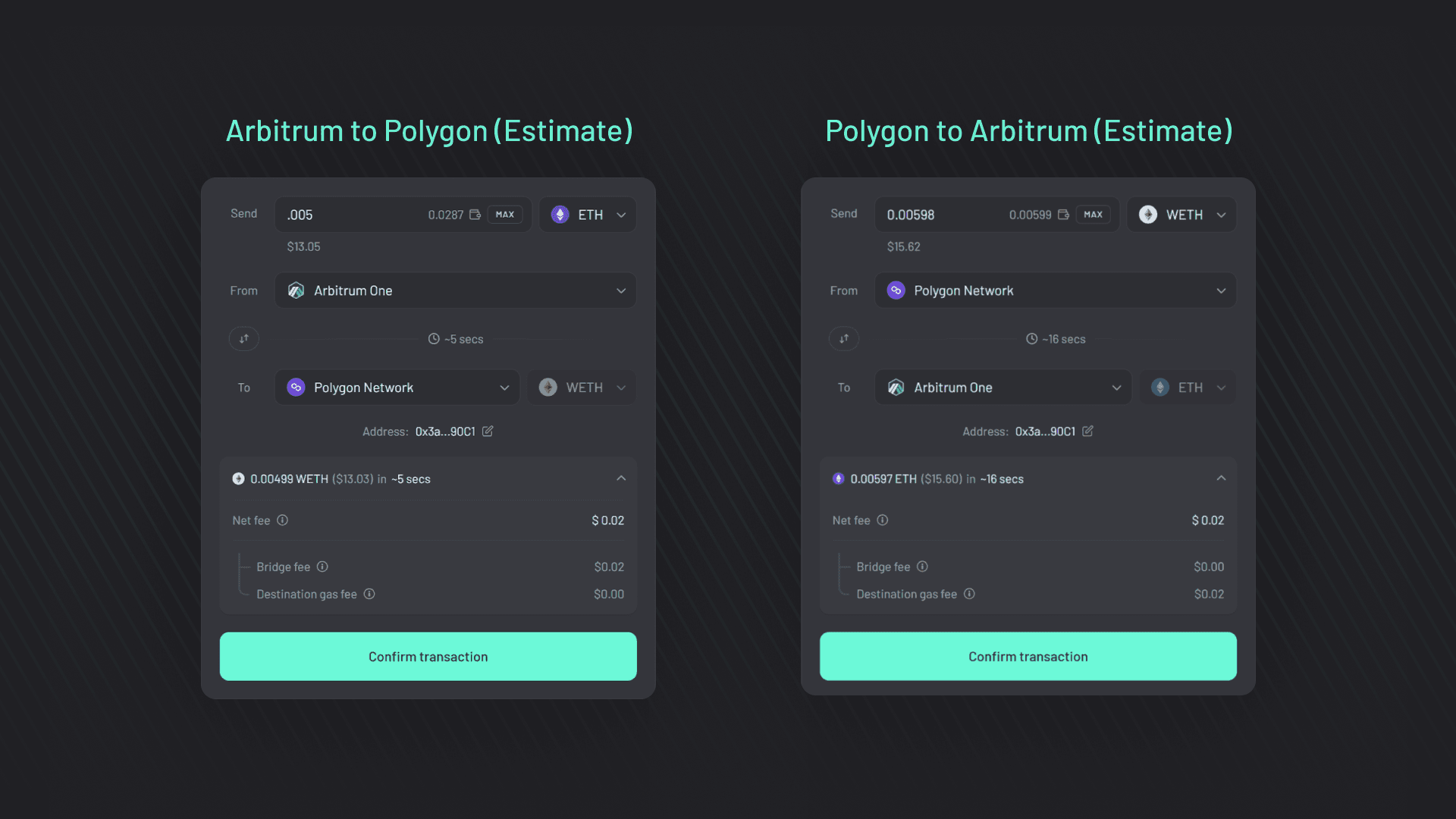
Fill time and fee estimates for bridging from Arbitrum to Polygon and vice versa.
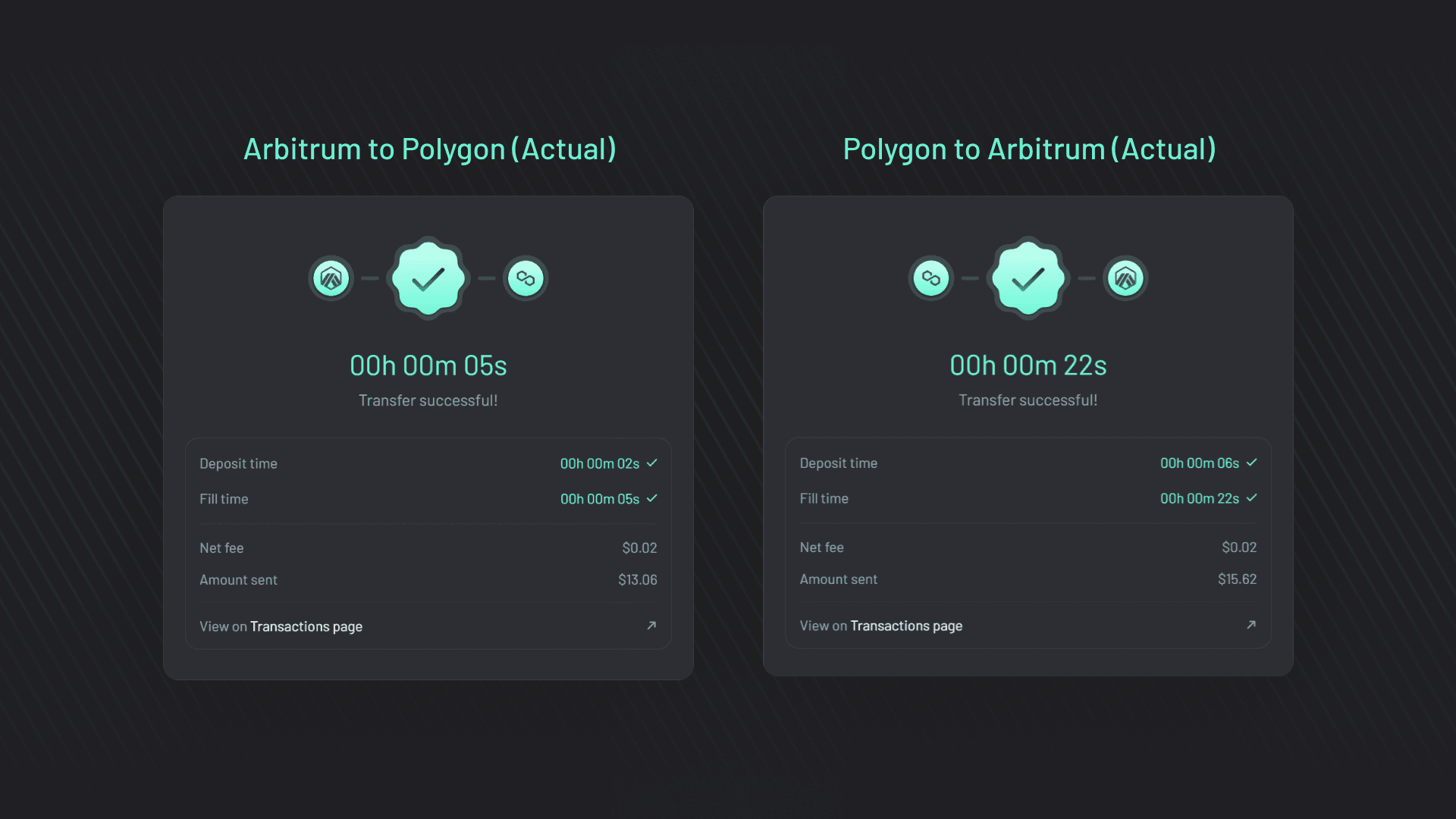
Actual fill time and fees for bridging from Arbitrum to Polygon and vice versa.

Fee breakdowns for bridging from Arbitrum to Polygon and vice versa.
Fast, Cheap, and Secure Bridging with Across
Across offers a superior solution as the fastest and most cost-effective way to bridge assets between Arbitrum and Polygon. With Across, users benefit from low fees, robust security, and an industry-leading bridging experience with times that average:
L1→L2: 15 sec
L2→L1: 10 sec
L2→L2: 3 sec
Notably, Across typically completes bridging between Arbitrum and Polygon in just a few seconds, even when wrapping or unwrapping ETH is involved. While minor delays can occur during asset conversions, Across remains significantly faster than native bridges, which can take 15+ minutes or even seven days in the case of withdrawals.
The Future of These L2s
As Ethereum Layer 2 solutions evolve, Arbitrum and Polygon are advancing distinct strategies to enhance scalability, interoperability, and decentralization. Notably, as the wider crypto market surfs the changing regulatory tides and broader institutional onboarding, both OP and Arbitrum are responding accordingly.
Arbitrum's Roadmap
Arbitrum is prioritizing customizability and decentralization, focusing on its Arbitrum Orbit framework, which enables developers to launch custom Layer 3 chains tailored to specific applications.
A key milestone for 2025 is the decentralization of its sequencer, which will distribute the responsibility of transaction ordering across a broader, decentralized network of participants, reducing the risk of censorship attacks and enhancing reliability.
Polygon’s Roadmap
Polygon is prioritizing modularity and interoperability through Polygon 2.0: An initiative that envisions a multichain ecosystem connected via an AggLayer. This framework aims to unify liquidity and enhance crosschain communication to create a seamless environment for users and developers.
Impact of Ethereum Upgrades
Ethereum’s recent upgrades (Dencun (EIP-4844) in early 2024 and Pectra in May 2025) have made it significantly cheaper and more efficient for Layer 2 networks to store and access data. These improvements have directly lowered transaction fees and increased throughput across the L2 ecosystem.
Arbitrum was quick to benefit thanks to its Nitro upgrade, which already optimized how the network handles and compresses transaction data. Polygon has also seen meaningful gains, particularly on its zkEVM rollup, where improved data availability supports faster and more cost-effective operations.
Additionally, Arbitrum and Polygon have been early supporters of ERC-7683: Ethereum’s universal standard for expressing crosschain intents. This standard enhances ecosystem interoperability by providing an open-sourced framework for developers who want to build protocols and applications with crosschain functionality. Now, over 70 projects (and counting!) support ERC-7683.
Looking ahead, these Ethereum upgrades are helping Arbitrum and Polygon double down on their respective scaling visions—Arbitrum with its growing Layer 3 Orbit ecosystem, and Polygon with its multichain roadmap powered by Polygon 2.0 and the AggLayer.
Arbitrum vs. Polygon: Final Thoughts
Ethereum’s rollup-centric future is already here, and Arbitrum and Polygon are two of the networks shaping what it looks like in practice. Each brings a unique philosophy to scaling: Arbitrum is built for performance and customizability, while Polygon leans into flexibility, ecosystem breadth, and brand adoption.
Arbitrum’s focus on Layer 3 innovation and efficient execution has made it a hub for DeFi protocols and high-performance applications. Its Nitro stack and Orbit framework give developers the tools to build scalable, purpose-specific chains without compromising on speed or cost.
Polygon, by contrast, has carved out its strength in modular scaling. With its PoS chain, zkEVM, and the rollout of Polygon 2.0 and the AggLayer, it offers multiple pathways for builders, whether they are optimizing for throughput, zk security, or multichain reach. Its ecosystem spans everything from enterprise loyalty programs to gaming to NFTs.
The right choice depends on your use case: DeFi-native teams may gravitate toward Arbitrum’s liquidity and customizability, while projects aiming for mainstream or cross-sector adoption may find more alignment with Polygon’s infrastructure.
Whichever path you take, moving assets between chains should be fast, affordable, and secure. Across makes it easy to bridge between Arbitrum and Polygon in seconds, without the delays or high fees of native solutions.
Ready to make the move? Try Across today.

